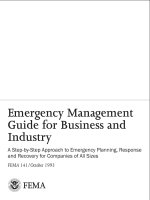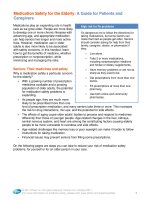sarbanes oxley guide for finance and info tech pros-0471785539
Bạn đang xem bản rút gọn của tài liệu. Xem và tải ngay bản đầy đủ của tài liệu tại đây (2.9 MB, 290 trang )
Sarbanes-Oxley
Guide for
Finance and
Information
Technology
Professionals
SANJAY ANAND
John Wiley & Sons, Inc.
ch00_FM_4621.qxd 1/24/06 12:09 PM Page iii
Sarbanes-Oxley
Guide for
Finance and
Information
Technology
Professionals
ch00_FM_4621.qxd 1/24/06 12:09 PM Page i
ch00_FM_4621.qxd 1/24/06 12:09 PM Page ii
Sarbanes-Oxley
Guide for
Finance and
Information
Technology
Professionals
SANJAY ANAND
John Wiley & Sons, Inc.
ch00_FM_4621.qxd 1/24/06 12:09 PM Page iii
This book is printed on acid-free paper.
Copyright © 2006 by Sarbanes Oxley Group. All rights reserved.
Published by John Wiley & Sons, Inc., Hoboken, New Jersey.
Published simultaneously in Canada.
No part of this publication may be reproduced, stored in a retrieval system, or transmitted in any
form or by any means, electronic, mechanical, photocopying, recording, scanning, or otherwise,
except as permitted under Section 107 or 108 of the 1976 United States Copyright Act, without
either the prior written permission of the Publisher, or authorization through payment of the
appropriate per-copy fee to the Copyright Clearance Center, Inc., 222 Rosewood Drive, Danvers,
MA 01923, 978-750-8400, fax 978-646-8600, or on the web at www.copyright.com. Requests
to the Publisher for permission should be addressed to the Permissions Department, John Wiley
& Sons, Inc., 111 River Street, Hoboken, NJ 07030, 201-748-6011, fax 201-748-6008, or online
at />Limit of Liability/Disclaimer of Warranty: While the publisher and author have used their best
efforts in preparing this book, they make no representations or warranties with respect to the
accuracy or completeness of the contents of this book and specifically disclaim any implied war-
ranties of merchantability or fitness for a particular purpose. No warranty may be created or
extended by sales representatives or written sales materials. The advice and strategies contained
herein may not be suitable for your situation. You should consult with a professional where
appropriate. Neither the publisher nor author shall be liable for any loss of profit or any other
commercial damages, including but not limited to special, incidental, consequential, or other
damages.
For general information on our other products and services, or technical support, please contact
our Customer Care Department within the United States at 800-762-2974, outside the United
States at 317-572-3993 or fax 317-572-4002.
Wiley also publishes its books in a variety of electronic formats. Some content that appears in
print may not be available in electronic books.
For more information about Wiley products, visit our Web site at .
SOCKET (Sarbanes-Oxley Compliant Key Enterprise Technology) is trademarked by the Sar-
banes-Oxley Group.
Library of Congress Library of Congress
Cataloging in Publication Division CIP 20540-4320
101 Independence Avenue, S.E. 9140 East Hampton Drive
Washington, DC 20540-4320 Capitol Heights, MD 20743
Library of Congress Cataloging-in-Publication Data
Anand, Sanjay.
Sarbanes-Oxley guide for finance and information technology professionals / Sanjay Anand.
p. cm.
Includes index.
ISBN-13: 978-0-471-78553-8 (cloth)
ISBN-10: 0-471-78553-9 (cloth)
1. United States . Sarbanes-Oxley Act of 2002. 2. Corporations—Accounting—Law and leg-
islation—United States. 3. Disclosure of information—Law and legislation—United States. 4.
Financial statements—Law and legislation—United States. I. Title.
KF1446.A945 2006
346.73 06648—dc22 2005031928
Printed in the United States of America
10987654321
ch00_FM_4621.qxd 1/24/06 12:09 PM Page iv
This guide is dedicated to my family and to the innocents who
have endured the harsh consequence of corporate fraud.
ch00_FM_4621.qxd 1/24/06 12:09 PM Page v
ch00_FM_4621.qxd 1/24/06 12:09 PM Page vi
vii
Contents
PREFACE xi
ACKNOWLEDGEMENTS xiii
INTRODUCTION 1
PART I
Sarbanes-Oxley For The Finance Professional 24
CHAPTER 1
Scope and Assessment of the Act 25
Integrity 25
Independence 25
Proper Oversight 26
Accountability 26
Strong Internal Controls 26
Transparency 26
Deterrence 27
Corporate Process Management 27
CHAPTER 2
Internal Controls 32
Components of Internal Control 33
Purpose of Internal Control 36
Developing an Internal Control System 37
CHAPTER 3
Control Environment 49
Risk Assessment 49
Information and Communication 54
Monitoring 56
CHAPTER 4
Material Weaknesses 58
Specific Internal Controls to Evaluate 58
Disclosure Committee 59
ch00_FM_4621.qxd 1/24/06 12:09 PM Page vii
CHAPTER 5
Implementing Sarbanes-Oxley: What Does Compliance Look Like? 62
Time Line 62
Checklists 64
Reporting, Documentation, and Archiving 72
Disclosure 72
CHAPTER 6
Technology Implications 74
Storage Systems 75
IT Solutions 77
Changes in IT Management 78
CHAPTER 7
Sarbanes-Oxley–Related Bodies 79
Public Company Accounting Oversight Board 79
Committee of Sponsoring Organizations 80
Securities and Exchange Commission 82
Financial Accounting Standards Board 83
CHAPTER 8
Opportunities and Challenges Created by Sarbanes-Oxley 84
Opportunities 84
Challenges 86
CHAPTER 9
Summary for the CFO 90
Changes to Corporate Governance 90
Catalyst for Improvement 91
PART II
Sarbanes-Oxley For The IT Professional 93
CHAPTER 10
Impact of Sarbanes-Oxley 95
Impact on the Enterprise, the CEO, and the CFO 95
Impact of Sarbanes-Oxley on Corporate Management Systems 97
Impact of Sarbanes-Oxley on the Technology Infrastructure 100
CHAPTER 11
Technologies Affected by Sarbanes-Oxley: From Sarbanes-Oxley to SOCKET 106
Separate Vendor Hype from Reality 106
Sarbanes-Oxley Compliance as an IT Project 107
Perspective on Sarbanes-Oxley Goals 108
Steps for Sarbanes-Oxley Compliance 109
viii
Contents
ch00_FM_4621.qxd 1/24/06 12:09 PM Page viii
Sarbanes-Oxley and The SEC 113
CHAPTER 12
Enterprise Technology Ecosystem 114
Organic IT Architecture 114
Ecosystem and Sarbanes-Oxley 115
CHAPTER 13
Implementing the SOCKET Methodology 117
Species or Components of the Enterprise Technology Ecosystem 117
COSO Framework 119
SOCKET Technologies 121
Transactional Systems: ERP, SCM, CRM 121
Analytical and Reporting Systems 126
Data Warehousing 129
CHAPTER 14
SOCKET and Enterprise Information Management 132
Document Management and Sarbanes-Oxley 132
Document Security 137
Communication and Networking 146
CHAPTER 15
The Process 150
Introduction to the Process 150
Strategic (Top-Down) Approach 155
Tactical (Bottom-Up) Approach 159
Monitoring the Audit Team 161
Implementation Process: Reengineering for Sarbanes-Oxley
Compliance 164
Beyond Sarbanes-Oxley: From SOCKET to Success Ecosystem 166
Conclusions 167
APPENDIX A Sarbanes-Oxley Implementation Plan: Developing an Internal
Control System for Compliance (Focusing on Sections 302 and 404) 169
APPENDIX B Project to Process: Making the House a Home 193
APPENDIX C Enterprise Project Management and the Sarbanes-Oxley
Compliance Project 220
APPENDIX D Enterprise Risk Management—Integrated Framework 224
APPENDIX E COBIT 3—Executive Summary 233
APPENDIX F COBIT 4—Executive Summary 247
INDEX 271
Contents
ix
ch00_FM_4621.qxd 3/20/06 1:07 PM Page ix
ch00_FM_4621.qxd 1/24/06 12:09 PM Page x
xi
Preface
(For updates and worksheets, visit www.SarbanesOxleyGuide.com.)
This book is a comprehensive, authoritative guide to getting your
organization compliant with Sarbanes-Oxley. It provides a founda-
tion and an advanced reference for finance and information technol-
ogy (IT) executives, professionals, and consultants who are involved
in or are looking to get involved in Sarbanes-Oxley–related compli-
ance projects. Among other things, the book addresses:
■
Key aspects and components of the Sarbanes-Oxley Act.
■
A methodology to achieve Sarbanes-Oxley compliancy for your
company.
■
The road map to compliance, including checklists, worksheets,
and project plans.
■
The business and technology implications and resource require-
ments for compliance.
■
The future of Sarbanes-Oxley and its impact on corporate Amer-
ica and the world.
The book includes practical, actionable advice that all finance and
IT professionals must have at their fingertips as they pursue, or con-
sider pursuing, a journey of Sarbanes-Oxley compliance. Because of
the enormity of the Act itself, this book is by no means all-encom-
passing. Nevertheless, it is a comprehensive guide and an extremely
valuable reference book for Sarbanes-Oxley compliance for your
organization.
Since the world of Sarbanes-Oxley is not static, and neither is the
body of knowledge associated with it, please visit www.Sarbanes
OxleyGuide.com for recent updates and new worksheets as they are
posted to the website.
ch00_FM_4621.qxd 1/24/06 12:09 PM Page xi
ch00_FM_4621.qxd 1/24/06 12:09 PM Page xii
xiii
Acknowledgements
Producing a comprehensive guide like this one requires a team effort.
I am grateful to my team at the Sarbanes-Oxley Group and elsewhere,
listed here in alphabetical order by last name, for assisting me with
the creation of this book:
Paul J. Boller, CPA, CISA, CIA, CFSA, in Switzerland
—for constructive feedback and edits.
Madeleine Ferris, CMA, CSOX, at FEI in Calgary, Canada
—for contributing to the appendices.
Vikas V. Gupta, PhD, at Inkorus in Bombay, India
—for helping to create the SOCKET Framework.
David Kimball, CMA, near Boston, Massachusetts
—for providing process-related content.
John LaCagnina, PMP, CSOX, at KPMG in New York
—for the project management aspects.
Dianna Podmoroff, CHRP, in Vancouver, Canada
—for the finance and human resource context.
Robert Schwind, CSOX, at GKBN in Albany, New York
—for security and related IT aspects.
Joann Skiba, Director, ISACA, in Chicago, Illinois
—for COBIT-related reprint permissions.
William Suda, AICPA in Jersey City, New Jersey
—for COSO-related reprinted permissions.
Jennifer Tran, CSOX, at Oracle in Teaneck, New Jersey
—for providing the enterprise context.
John Wiley & Sons, Inc.’s staff across the United States
—for editorial and publishing expertise.
Thanks also to our families, who allowed us to spend many nights
and weekends working on this guide so that we could bring it to you.
ch00_FM_4621.qxd 1/24/06 12:09 PM Page xiii
ch00_FM_4621.qxd 1/24/06 12:09 PM Page xiv
1
Introduction
The Enron fiasco forever changed investor and public reliance on self-
regulation measures for accounting and financial reporting. Not since
the stock market crash of 1929 and the Great Depression in the 1930s
has so much attention been paid to federal securities laws and finan-
cial and reporting methodology for public companies. The result has
been a staggering shock to the financial and information systems of
public companies, as executives and their boards scramble to make
sense of, and comply with, the new regulations.
The Sarbanes-Oxley Act of 2002 (PUBLIC LAW 107–204—JULY
30, 2002 - 116 STAT. 745) was enacted after the Enron and World-
Com debacles, in response to the resulting dramatic loss of faith in the
governance of public companies. As a remedial measure, this Act sig-
nificantly affects the day-to-day functions of all top-level manage-
ment and executives of public companies, particularly the CEO, the
CFO, and top information officers.
The Act created a five-member Public Company Accounting
Oversight Board (PCAOB), which has the authority to set and
enforce auditing, attestation, quality control, and ethics (including
independence) standards for public companies. The Act gives the
PCAOB the right to impose disciplinary and remedial sanctions for
violations of the board’s rules, securities laws, and professional
auditing standards. The Securities and Exchange Commission (SEC)
has adopted many of the Sarbanes-Oxley provisions, and the
breadth and depth of these changes ensure that CEOs, CFOs, and
CIOs must pay close attention to the systems the corporation has set
for reporting and auditing of all financial information and securities
transactions.
The main goal of the Sarbanes-Oxley Act is to protect investors
and increase their confidence in public companies. Specific measures
of the Act require that a company’s CEO and CFO each certify quar-
terly and annually that:
ch00_FM2_4621.qxd 1/24/06 12:14 PM Page 1
He or she reviewed the report being filed.
To his or her knowledge, the report does not contain any untrue
statements or omit any material facts.
The financial statements and other financial information fairly
present, in all material respects, the financial position, results of
operations, and cash flows.
He or she is responsible for, and has designed, established, and
maintained, disclosure controls and procedures (DC&P), as well
as evaluated and reported on the effectiveness of those controls
and procedures within 90 days of the report filing date.
Effectively, this means that on a daily basis, the certifying offi-
cers need to ensure that systems are set up and monitored suffi-
ciently to satisfy themselves that all disclosure procedures and
controls are operating effectively. In its comment on the Act, the
SEC stated:
An overall purpose of internal control over financial reporting is to
foster the preparation of reliable financial statements. Reliable
financial statements must be materially accurate. Therefore, a cen-
tral purpose of the assessment of internal control over financial
reporting is to identify material weaknesses that have, as indicated
by their very definition, more than a remote likelihood of leading to
a material misstatement in the financial statements. While identify-
ing control deficiencies and significant deficiencies represents an
important component of management’s assessment, the overall
focus of internal control reporting should be on those items that
could result in material errors in the financial statements.
1
Although the Sarbanes-Oxley Act has not established specific
rules and standards for reporting on internal controls and procedures
for financial reporting, it is the responsibility of the CEO, CFO, and
CIO to establish these guidelines and manage them diligently to
remain in compliance with the Act. Ultimately, this Act guarantees
that a corporation’s commitment to transparent and ethical reporting
methodology is as important as its commitment to its bottom line;
and government, investors, and the public are looking to top execu-
tives to make this happen.
2
Introduction
ch00_FM2_4621.qxd 1/24/06 12:14 PM Page 2
EVENTS LEADING UP TO THE ACT
The last major crisis that prompted a serious overhaul of the account-
ing and financial reporting standards for public companies came after
the stock market crash of 1929. The crash resulted in vast investor
losses and the subsequent financial depression. The federal govern-
ment’s response was to establish the Securities and Exchange Com-
mission by the Securities Act of 1933 and the Securities Exchange Act
of 1934. The SEC was given statutory authority to set accounting
standards and oversight over the activities of auditors. The role of
establishing auditing standards was left to the accounting profession.
The accounting profession formed a series of committees that,
between 1938 and 1959, issued 51 authoritative pronouncements
that formed the basis of what is now known as generally accepted
accounting principles (GAAP). Today, the Financial Accounting Stan-
dards Board (FASB) sets the ground rules for measuring, reporting,
and disclosing information in financial statements of nongovernmen-
tal entities. These accounting standards cover a wide range of topics:
everything from broad concepts, such as revenue and income recog-
nition, to more specific rules, such as how to report information
about the company’s different businesses. The SEC officially recog-
nizes the FASB’s accounting standards as authoritative.
REGULATION OVERHAUL
For the past 60 years, the U.S. accounting profession’s system of self-
regulation—including peer review, a Public Oversight Board (POB),
Quality Control Inquiry Committee (QCIC), Professional Ethics Divi-
sion, and Continuing Professional Education (CPE)—has helped cre-
ate one of the most respected financial markets in the world. Then the
plight of Enron spurred a public debate over the effectiveness and
ethics of the financial accounting, reporting, and auditing processes.
On December 2, 2001, less than a month after it admitted to
accounting errors and irregularities that had inflated earnings by
almost $600 million since 1994, Enron Corporation filed for bank-
ruptcy protection. With $62.8 billion in assets, it became the largest
bankruptcy in U.S. history.
Introduction
3
ch00_FM2_4621.qxd 1/24/06 12:14 PM Page 3
The day Enron filed for bankruptcy, its stock closed at 72 cents,
down more than $75 from a year earlier. Many employees lost their
life savings, and tens of thousands of investors lost billions. Shortly
after this, WorldCom, crippled by $41 billion in debt and a recent dis-
closure that it had hidden $3.9 billion in expenses, filed for bank-
ruptcy protection with $107 billion in assets, thus taking over the
title of the largest bankruptcy ever filed in the United States.
GOVERNMENT REACTION
On July 30, 2002, President George W. Bush signed into law the Sar-
banes-Oxley Act of 2002; the most dramatic change to federal secu-
rities laws since the 1930s. The Act dramatically redesigns federal
regulations regarding corporate governance and reporting obligations
of public companies. It also significantly tightens accountability stan-
dards for directors and top executives, including the CEO, CFO, CIO,
auditors, securities analysts, and legal counsel.
The Act is organized into 11 titles dealing with auditor indepen-
dence, corporate responsibility, enhanced financial disclosures, con-
flicts of interest and corporate accountability, among other things (see
Exhibit I.1).
Key Components of the Act
Sections 301 through 308, dealing with corporate responsibility, and
Sections 401 to 409, dealing with enhanced financial disclosures, are
the most compelling sections and the ones that have received the most
attention and analysis. Section 302, pertaining to disclosure controls
and procedures, and Section 404, pertaining to internal controls and
procedures for financial reporting, are the two sections that are most
relevant and have received the most scrutiny.
Section 302 mandates that with each quarterly filing, the CEO
and CFO must each certify that they have evaluated the accuracy and
effectiveness of the corporation’s internal controls. In addition, they
must disclose all significant deficiencies, material weaknesses, and
acts of fraud. Section 906 also requires certification of the financial
reports in a separate document. Section 404 requires an annual eval-
4
Introduction
ch00_FM2_4621.qxd 1/24/06 12:14 PM Page 4
uation of internal controls and procedures of financial reporting and
auditing. Under these provisions, a company must document its inter-
nal control mechanisms that have a direct impact on its financial
reporting, evaluate them for compliance, and disclose any gaps and
deficiencies. For further control, an independent auditor must issue a
written report that attests to management’s certification on the effec-
tiveness of the corporation’s internal financial and audit controls, its
procedures, and its financial reporting.
For the first time in history, failure to comply with the certifica-
tion and disclosure requirements can and will result in personal crim-
inal liability (steep fines and/or imprisonment) for the executives
involved. According to the new legislation, “corporate negligence is
equally sanctionable as deliberate malfeasance.”
It is clear that familiarity with the compliance requirements of the
Sarbanes-Oxley Act is critical from both a corporate and personal
standpoint. Although the entire Act is too large for this book to cover
every regulation in detail, there are some key regulations implement-
Introduction
5
EXHIBIT I.1
Components of the Sarbanes-Oxley Act
Components Sections
Title I Public Company Accounting Oversight 101–109
Title II Auditor Independence 201–209
Title III Corporate Responsibility 301 –308
Title IV Enhanced Financial Disclosures 401–409
Title V Analyst Conflicts of Interest 501
Title VI Commission Resources and Authority 601–604
Title VII Studies and Reports 701–705
Title VIII Corporate and Criminal Fraud Accountability 801–807
Title IX White-Collar Crime Penalty Enhancements 901–906
Title X Corporate Tax Returns 1001
Title XI Corporate Fraud and Accountability 1101–1107
ch00_FM2_4621.qxd 1/24/06 12:14 PM Page 5
ing the critical sections of Sarbanes-Oxley that executives and man-
agers alike need to be aware of:
■
Section 101: Public Company Accounting Oversight Board
(PCAOB) Membership. The board shall consist of five full-time
members (two CPAs and three non-CPAs) who are all financially
literate. No member of the board may be receiving payment or
sharing in the profit of any public accounting firm other than
retirement benefits or other fixed payments. The chair may not
have practiced as a CPA within the previous five years.
■
Section 103: PCAOB’s Duties. The board is responsible for:
●
Setting the budget and managing its operations.
●
Establishing “auditing, quality control, ethics, independence,
and other standards relating to the preparation of audit reports
for issuers.”
●
Registering and inspecting accounting firms.
●
Investigating irregularities and imposing appropriate sanctions.
●
Enforcing compliance with the Act and other laws or standards
relating to the preparation and issuance of audit reports.
●
Performing other duties as required.
The board must adopt an audit standard to implement the
internal control review required by Section 404.
■
Section 105: PCAOB Investigations. Information received or pre-
pared by the PCAOB shall be “confidential and privileged as an
evidentiary matter (and shall not be subject to civil discovery or
other legal process) in any proceeding in any Federal or State
court or administrative agency, unless and until presented in con-
nection with a public proceeding or [otherwise] released.” No
sanctions report will be made available to the public unless and
until stays pending appeal have been lifted.
■
Section 107(d): PCAOB Sanctions. The SEC has the right to
require the board to carry out additional responsibilities, such as
keeping certain records, and it can inspect the board as necessary.
■
Section 107(c): Review of Disciplinary Action Taken by the
PCAOB. The SEC can change, cancel, reduce, or increase sanc-
tions applied by the board.
■
Section 108: Accounting Standards. The SEC recognizes GAAP
and all the principles therein, and any new procedures must
adhere to the GAAP principles.
6
Introduction
ch00_FM2_4621.qxd 1/24/06 12:14 PM Page 6
■
Section 201: Prohibited Activities of Professional Service
Providers. The firm that supplies auditing services to a client can-
not provide bookkeeping or other accounting record service to
the audit client; financial information systems design and imple-
mentation; appraisal or valuation services; actuarial services;
internal audit outsourcing services; management functions or
human resources; brokerage, investment adviser, or investment
banking services; legal services; or any other service that the board
determines, by regulation, is impermissible.
■
Section 206: Conflict of Interest. The CEO, controller, CFO, and
so on cannot have worked for the company’s external audit firm
in the year preceding the audit.
■
Section 301: Public Company Audit Committees. The audit com-
mittee is to be made up of board members who are guaranteed to
be independent and free of interests that conflict with those of the
corporation.
■
Section 302: Certification. CEOs and CFOs must certify in each
reporting period that the information presented is accurate and
fairly represents the financial position of the company and oper-
ational results. Certifying officers will face penalties for false cer-
tification of $1 million and/or up to 10 years’ imprisonment for a
“knowing” violation and $5 million and/or up to 20 years’
imprisonment for a “willing” violation.
■
Section 304: Forfeiture of Certain Bonuses and Profits. If an
issuer is required to prepare an accounting restatement due to a
material noncompliance of the issuer, as a result of misconduct,
with any financial reporting requirement under the securities
laws, the CEO and CFO of the issuer shall reimburse the issuer
for any bonus or other incentive-based or equity-based compen-
sation received by that person from the issuer during the 12-
month period following the first public issuance or filing with the
SEC (whichever first occurs) of the financial document embody-
ing such financial reporting requirement; and any profits realized
from the sale of securities of the issuer during that 12-month
period.
■
Section 306: Blackout Periods. Officers, directors, and other
insiders may not purchase or sell stock during blackout periods.
■
Section 401(a): Disclosures in Periodic Reports. All financial
reports are to be prepared according to GAAP and shall “reflect
Introduction
7
ch00_FM2_4621.qxd 1/24/06 12:14 PM Page 7
all material correcting adjustments . . . that have been identified
by a registered accounting firm ”
■
Section 401 (c): Off-Balance Sheet Disclosures. The SEC shall
study off-balance sheet disclosures to determine the extent of the
transaction and whether GAAP rules were applied such that the
transactions are transparent to investors.
■
Section 402: Prohibition of Personal Loans to Executives. No
public company, except consumer credit institutions, may loan or
renew a loan of a personal nature to its executive officers or direc-
tors. A credit company may issue consumer loans and credit cards
to its directors and executive officers if it does so in the ordinary
course of business on the same terms and conditions offered to the
general public.
■
Section 403: Disclosures of Insider Trades. Directors, officers, and
10 percent owners must report insider trades within two business
days of the transaction.
■
Section 404: Internal Controls. Management must state their
responsibility in establishing, maintaining, and analyzing the
internal control structure, and must assess the effectiveness of
such processes.
■
Section 406: Codes of Ethics. A corporation is required to have a
code of ethics that addresses financial data and record integrity.
If a corporation does not have a code of ethics it must justify its
position.
■
Section 407: Financial Expert. At least one member of the audit
committee must be a “financial expert,” a person who has edu-
cation and experience as a public accountant, auditor, principal
financial officer, controller, or principal accounting officer.
■
Section 409: Real-Time Disclosure. Issuers must disclose infor-
mation on material changes in the financial condition or opera-
tions of the issuer on a rapid and current basis.
■
Title VIII: Corporate and Criminal Fraud:
●
It is a felony to “knowingly” obstruct a federal investigation by
tampering with documents or other such actions.
●
Auditors are required to maintain records for five years.
●
Section 806—Employees are given “whistleblower protection”
that prohibits the employer from taking retaliatory action
against employees who disclose information relevant to a fraud
claim.
8
Introduction
ch00_FM2_4621.qxd 1/24/06 12:14 PM Page 8
■
Title IX: White-Collar Crime:
●
Maximum imprisonment for mail and wire fraud is increased
from five to ten years.
●
Tampering with a record or otherwise obstructing a proceed-
ing is a crime.
●
A CEO or CFO who knowingly or willfully certifies financial
reports that are misleading faces a fine of up to $5 million
and/or imprisonment of up to 20 years.
■
Section 1102: Tampering with a Record. It a crime to alter,
destroy, or conceal any document with the intent to obstruct an
official proceeding; the penalty is up to 20 years in prison and a
fine.
■
Section 1105: Prohibited Board Members. A person who has
committed securities fraud may be prohibited by the SEC from
serving as a board member.
IMPACT OF THE ACT
The Sarbanes-Oxley Act of 2002 requires public companies to validate
the accuracy and integrity of their financial accounting and reporting
processes, and the management thereof. The processes and documen-
tation required for compliance are rigorous and require a commitment
from all members of the organization. From the CEO to the account-
ing clerk to the information specialist, all employees must operate
using ethical and accurate standards, and those standards must be
communicated through, and reinforced by, the corporate culture.
SARBANES-OXLEY AND CORPORATE CULTURE
It is one thing to create new laws and regulations and expect compa-
nies to follow them, but it is an entirely different matter to efficiently
implement those changes. That is where corporate culture comes into
play. The “tone from the top” is a crucial element in achieving change
of this magnitude and importance.
The message prior to Sarbanes-Oxley was primarily profit driven;
now corporate communication needs to emphasize realistic expecta-
tions and goals for the company and staff. This means that, from set-
ting sales targets to planning budgets, all goals must be fundamentally
Introduction
9
ch00_FM2_4621.qxd 1/24/06 12:14 PM Page 9









